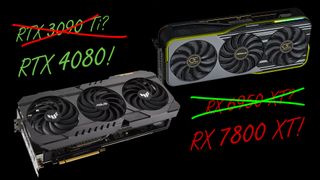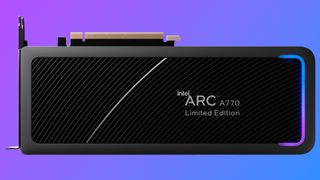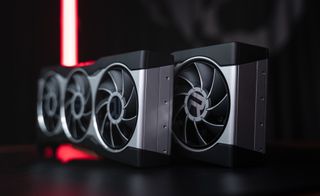Don't Buy a Graphics Card for More than $500 Right Now
New, high-end cards will shake up the market very soon.

If you're looking to upgrade your PC with a new, high-end graphics card that costs more than $500, hit the pause button. While GPU prices continue to drop and some cards might look particularly tempting — like the RTX 3090 Ti for $920 below its obscene $1,999 launch MSRP — the best graphics cards are about to get some serious competition. That's especially true for the cards at the top of our GPU benchmarks hierarchy. So if you're eying that RX 6950 XT for 'only' $934, I suggest you wait.
Today's top cards — anything that's above an RTX 3070 or, quite possibly, an RTX 3070 itself — are likely to be displaced by faster models within the next two or three months. If you buy such a card now, you may kick yourself in November when you can get a better card for the same price, or the same, now-last-gen card at a discounted price. Still, cards that currently cost $500 or less, like the RTX 3060 Ti or below and RX 6700 XT or below, are less likely to be replaced in the near future. However, I'd suggest sticking to the sub-$250 space if you can't wait, as it's hard to beat the value you get right now from Radeon RX 6600 and RTX 2060.
If you need three good reasons to wait on upgrading your graphics card, I've got them: Nvidia RTX 40-series Ada Lovelace GPUs, AMD RX 7000-series RDNA 3 GPUs, and Intel Arc Alchemist GPUs. That last one probably won't land anywhere near the top of the performance ladder, but if Intel wants to gain some market share the A770, A750, and A580 could be priced very aggressively. That could cause AMD and Nvidia to respond with price cuts to the midrange and budget GPUs. In other words, everything is in a state of flux, from budget to midrange to high-end and extreme GPUs.
Which isn't to say nobody should purchase a new graphics card. If you're in dire need, or if you're building your first PC and simply can't wait any longer, it's okay to buy a decent budget or midrange offering. There's always new stuff coming down the pipeline, and potentially waiting until 2023 is probably too long for some people. Again, there's less likelihood of major pricing changes in the budget to midrange sector, so if you need a new GPU, that's where I'd look.
Let's quickly recap what's happening at the top of the GPU performance stack.

Everyone expects Nvidia to reveal the RTX 4090 at the very least on September 20 at the GPU Technology Conference. Nvidia has said it will talk about the next GeForce architecture, and why discuss the architecture without launching at least one graphics card? Nvidia will probably provide details on the RTX 4080 as well, and maybe even a Titan card.
Rumblings about performance indicate we could be looking at far more than a 50% improvement over the current fastest GPUs. Prices might set new records as well — in a bad way — but if you're considering upgrading to a new Nvidia GPU that costs more than $500, I'd definitely wait and see what happens. And if you're eying an RTX 3090 Ti, you might as well wait a month and then go whole hog and swipe your credit card for the RTX 4090, assuming it really is up to 75% faster. Or be sensible and pick up the RTX 4080.
In short, I fully expect RTX 4090 cards to go on sale by October at the latest. There's a good chance RTX 4080 will follow within a few weeks, if it doesn't launch concurrently. That will put pressure on Nvidia and its partners to clear out everything from the 3080 and up, which in turn should impact prices on the 3070 and 3060 series as well.

AMD may not be too far behind with its RDNA 3 GPUs. It demonstrated an unnamed but presumably high-end card at the unveiling of the full Ryzen 7000 CPU lineup. Let the dust settle from the CPU launch, which will happen on September 27, and AMD might be ready to shift over to new GPU launches by next month, certainly before the end of the year.
As with Nvidia, I expect AMD to start with its fastest GPU, Navi 31. The top model should have at least 50% more memory bandwidth and capacity compared to the RX 6950 XT, and if the current rumors are accurate, it will more than double the theoretical compute performance. Will AMD steal some of Nvidia's thunder and deliver a GPU that can beat the RTX 4090? It's possible, though we'll have to wait and see. The bad news is that if AMD actually does deliver superior performance, it will likely be equally expensive.
But again, you don't need to splurge on the top-shelf model. AMD should have a slightly trimmed down RX 7800 XT launching at the same time as or shortly after the RX 7900 XT. The potential for massive changes in price to performance don't stop there, either. RX 6700 XT is probably about as high as I'd go on a GPU purchase, as the newcomers will inevitably affect prices elsewhere, though the further down the stack you go, the less likely things are to change much in the next month or two.

The budget to midrange sector is also where Intel's higher spec Arc graphics cards come into the picture. Intel has demonstrated — using its own benchmarks, so apply a dose of skepticism — competitive performance from both the Arc A770 and Arc A750. Based on the recently published Arc specs, even the mainstream Arc A580 might offer some decent competition in the sub-$250 market.
Intel knows where things stand, and it knows it has an uphill battle for market share. Earlier reports of flaky drivers on the Arc A380 aren't going to instill confidence, which means even if Intel's Arc A770 can match or beat the RTX 3070, it won't be able to charge RTX 3070 prices.
I suspect Intel's A770 will go after the RTX 3060 Ti instead, the A750 will target the RTX 3060, and A580 will take on the RTX 3050. Possibly even more surprising is that Intel might even win each of those match ups. At which point Nvidia could easily reduce prices, which again points back to the recommendation to wait a bit.
| Graphics Card | RTX 4090 | RTX 3090 Ti | RX 7900 XT | RX 6950 XT | Arc A770 |
|---|---|---|---|---|---|
| Architecture | AD102 | GA102 | Navi 31 | Navi 21 | ACM-G10 |
| Process Technology | TSMC 4N | Samsung 8N | TSMC N5 + N6 | TSMC N7 | TSMC N6 |
| Transistors (Billion) | ? | 28.3 | ? | 26.8 | 21.7 |
| Die size (mm^2) | ? | 628.4 | 308 + 228 | 519 | 406 |
| SMs / CUs / Xe-Cores | 128? | 84 | 92? | 80 | 32 |
| GPU Shaders | 16384? | 10752 | 11776? | 5120 | 4096 |
| Tensor/XMX Units | 512? | 336 | —? | — | 512 |
| Ray Tracing Units | 128? | 84 | 92? | 80 | 32 |
| Boost Clock (MHz) | 2000? | 1860 | 2500? | 2310 | 2100 |
| VRAM Speed (Gbps) | 24? | 21 | 18? | 18 | 17.5 |
| VRAM (GB) | 24 | 24 | 24 | 16 | 16/8 |
| VRAM Bus Width | 384 | 384 | 384 | 256 | 256 |
| Last Level Cache (MB) | 96 | 6 | 192 / 96 | 128 | 16 |
| ROPs | 192? | 112 | 192? | 128 | 128 |
| TMUs | 512? | 336 | 368? | 320 | 256 |
| TFLOPS FP32 | 65.5? | 40.0 | 58.9? | 23.7 | 17.2 |
| TFLOPS FP16 | 262 (524)? | 160 (320) | 117.8? | 47.4 | 138 |
| Bandwidth (GBps) | 1152? | 1008 | 864? | 576 | 560 |
| TDP (watts) | 450? | 450 | 400? | 335 | 225 |
| Launch Date | Oct 2022? | Mar 2022 | Nov 2022? | May 2022 | Sep 2022? |
| Launch Price | $1,999? | $1,999 | $1,499? | $1,099 | $399? |
I've put all of the rumored specifications together — though the A770 doesn't have rumored specs anymore, other than the price. I'm reasonably certain on the maximum configuration for Nvidia's AD102 GPU and Nvidia's Navi 31, but how many of the functional will actually be enabled, and what clock speeds will the chips run at? These are basically unknown, at least to me, though there have been loads of rumors — many less reliable than others. I've also plugged in "educated guess" pricing, but remember that price is the easiest thing to change at the last minute.
Arguably the most important specifications will be the GPU shader counts and theoretical compute. Experience indicates that such data ends up being a comparison between apples and oranges due to the differences between the various architectures, but assuming AMD and Nvidia both improve, and depending on final clock speeds, we could be in for a very interesting showdown in the next month or two.
For the current generation GPUs, Nvidia has a whopping 40 teraflops of theoretical compute on the RTX 3090 Ti, while the RX 6950 XT only has 23.7 teraflops. The potential specs for RTX 4090 put it at around 65 teraflops — a 60% increase — while the RX 7900 XT could go as high as 59 teraflops or more — more than double the current halo AMD GPU. Intel lands far below those two, with the A770 already behind the existing halo parts, but again that's to be expected since it will be going after the higher volume mainstream market.
Perhaps more important than the upcoming AMD and Nvidia heavyweights will be the penultimate GPUs. RTX 4090 and RX 7900 XT will almost certainly carry premium pricing to new levels, but what about RTX 4080 and RX 7800 XT? Past experience suggests stepping down one notch might reduce potential performance by 10–15%, while also cutting the price nearly in half. $999 for an RTX 4080 that's 30% faster than the existing RTX 3090 Ti? Yeah, that's one possibility. The same goes for RX 7800 XT versus the RX 7900 XT.

Again, I don't know for sure where any of these upcoming cards will actually land on price or performance, or even specifications. That's why I run all the benchmarks when the GPUs actually launch. About the only thing I'm confident in stating is that all the new GPUs will immediately sell out. What I hope is that supply will catch up to demand much more quickly than in the past two years. Miners won't be propping up unreasonable prices, so if the stars align we could see decent availability and pricing before the end of the year.
And even if the prices on the next-generation GPUs end up being more than you're willing to spend, the reported glut of current generation graphics cards building up in warehouses should inevitably lead to lower prices on existing cards. Worst-case, you wait a month or two and end up saving a few bucks (unless another "perfect storm" hits). Best-case, you end up with a 50% or more increase in performance without spending anything extra.
But hey, I've been wrong before, though admittedly not many people properly predicted the ramifications of the whole pandemic, or the 2020 cryptocurrency boom causing chaos in the GPU market. Unfortunately, even without those, scalpers might ruin the upcoming launch parties and holiday shopping season. Patience is still a virtue.
Like I said at the start, if you really need something right now, I'd look to cards priced below $500, and probably closer to $250. Take a gander at the Radeon RX 6600 and RTX 2060, both of which are excellent values. You can move up to something faster once things settle down. If those aren't fast enough, AMD's RX 6700 XT and RX 6650 XT are also good values, and the 12GB of VRAM on the 6700 XT and RTX 3060 also warrant consideration.
I wouldn't go much higher on a GPU purchase right before new hardware is set to arrive. There's usually a trickle down effect on pricing, and Nvidia's cards in the $300–$600 range are still selling above their official MSRPs, which means they definitely have room to come down another $50–$100.
Stay on the Cutting Edge
Join the experts who read Tom's Hardware for the inside track on enthusiast PC tech news — and have for over 25 years. We'll send breaking news and in-depth reviews of CPUs, GPUs, AI, maker hardware and more straight to your inbox.
Jarred Walton is a senior editor at Tom's Hardware focusing on everything GPU. He has been working as a tech journalist since 2004, writing for AnandTech, Maximum PC, and PC Gamer. From the first S3 Virge '3D decelerators' to today's GPUs, Jarred keeps up with all the latest graphics trends and is the one to ask about game performance.
-
AndrewJacksonZA *chuckle *Reply
I just ordered an AMD RX 6800 XT (the XFX Speedster MERC319) LITERALLY 22 HOURS AGO for roughly USD550. I simply couldn't wait any longer as I replaced my (12yr old) 1080p display with a new 43" 4K Freesync Premium Pro display primarily for work and secondarily for play and my RX470 4GB just won't cut the mustard anymore.
RDR2 getting FSR 2.1 also swayed my vote. Since my goal is to play RDR2 at 4k, I was eyeing a 3080 12GB, but the price just refused to drop in my country below roughly USD750.
This is the first time I'm "upgrading"/getting a new computer in pieces and not in one shot since roughly 1992, so it's a strange experience for me. :) -
AndrewJacksonZA Reply
Ouch, I didn't even think about that. I bought a Super Flower Leadex III Gold 850W in the same transaction for roughly USD100 which Aris seems to say is a decent one.tummybunny said:Don't forget US$230+ for a new ATX 3.0 PSU for the new Nvidia high end cards. -
InvalidError Reply
Early adopter tax. Give it a year or two, you'll be able to get compliant PSUs from $150 or less as long as you don't mind giving up a couple of bells and whistles.tummybunny said:Don't forget US$230+ for a new ATX 3.0 PSU for the new Nvidia high end cards. -
btmedic04 This mentality worked out great last generation....for the bot using scalpers. These new gpus will undoubtedly be faster, but how long will folks have to wait for supply to outpace scalpers? Current gen gpus aren't going to suddenly become useless paperweightsReply -
Exploding PSU ReplyAndrewJacksonZA said:*chuckle *
I just ordered an AMD RX 6800 XT (the XFX Speedster MERC319) LITERALLY 22 HOURS AGO for roughly USD550....
Me who bought a 6800XT for 2000+ AUD back in February : chuckles... and cries
Well whatever happens, happens. Good for you though, welcome to the world of DIY PC! That's a bang good deal for a GPU. -
InvalidError Reply
Without another crypto-boom sucking up most of the first ~10 million next-gen GPUs straight from manufacturers, scalpers won't be able to turn much of a profit beyond the first month or two, which is about how long it normally takes for availability to stabilize after launch.btmedic04 said:These new gpus will undoubtedly be faster, but how long will folks have to wait for supply to outpace scalpers?
Also keep in mind that Nvidia was desperate to cancel 5nm wafer starts and TSMC told it to go play with itself, which means Nvidia may have many more RTX4000 dies available than it wanted to after sales slowed down on top of excess inventory of 3000-series parts. -
cAllen Bought my EVGA 3090 Ti Ultra 2 weeks ago for $1,257 "out the door". Considering I saw asking prices of $2200-$2500 months before...if you could get one...I did better than those who purchased before.Reply
To me this was like buying a car when the new year model comes out. It's all about timing. If you buy early you always pay more, but get exactly what you want. If you wait until right before or after the new ones come out it's cheaper, but you have to pick from the left overs.
YMMV -
ThatMouse I find it hard to believe you'll be able to buy a 4080 by Christmas. Historically even before the covid you had to overpay or get lucky.Reply -
Indianajonze this is terrible advice. 1. even if they launch in october, that's at least a good month without a gpu (if you're building new). 2. the prices will be no where near 900 for a 3090 ti at launch if history is any guide. double most likely. 3. if you buy now from a good dealer you should have 30 days to return should the stars align in our favor and there's stock at a reasonable price. 4. far better to take advantage of the 50% discounts on current gen now and then upgrade later if necessary. you could recoup at least 60-70% of your cost if you sell in the next 3-4 months. 5. do you really trust these companies to have stock for sale to the common man after the last gen fiasco? a bird in the hand is worth two in the bush as they say...Reply
Most Popular





